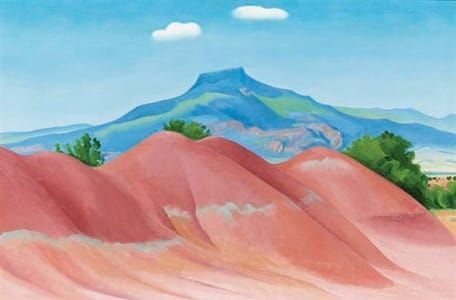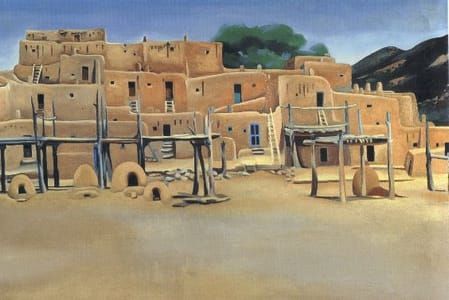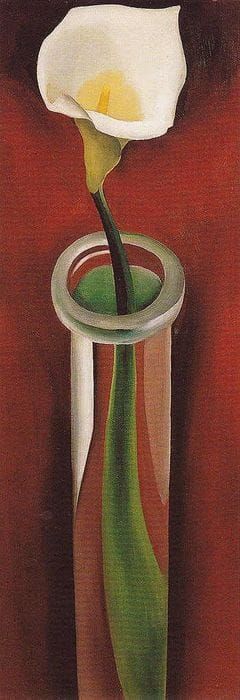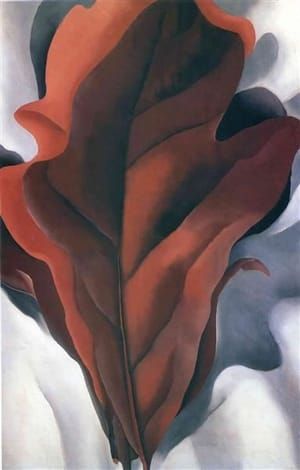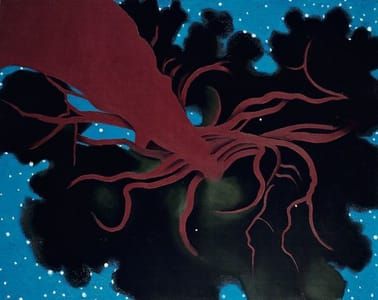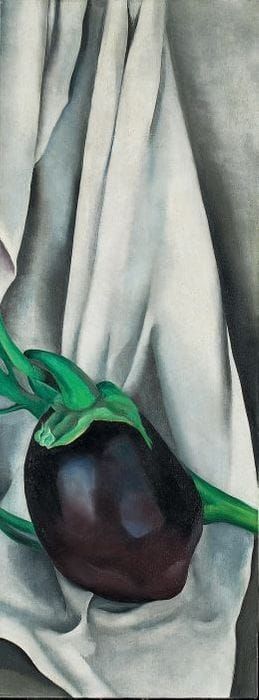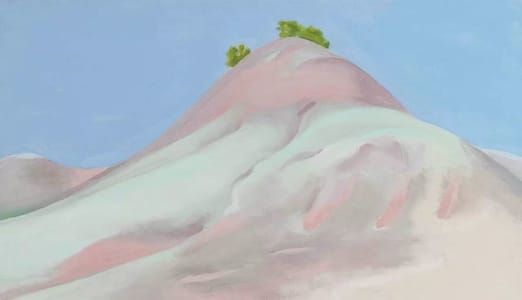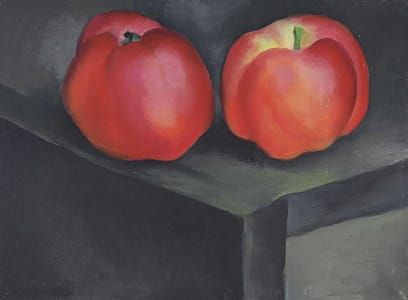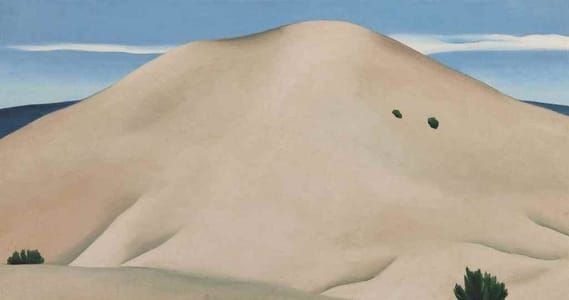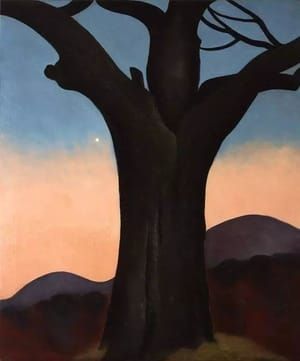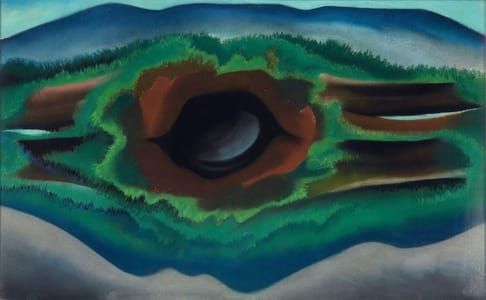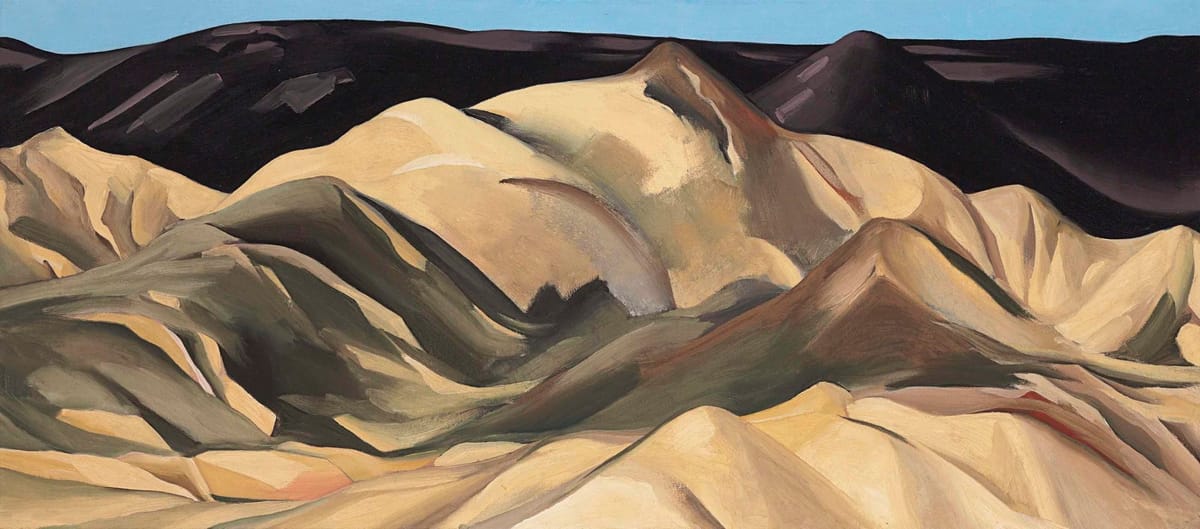

Near Abiquiu, New Mexico, 1931
Georgia O'Keeffe
When Georgia O’Keeffe first visited New Mexico in 1929, she was instantly captivated by the rugged, open landscape and the spiritual character of the area. During her frequent visits in the following years and after her permanent move in 1949, O’Keeffe famously captured the natural beauty of the Southwest in a modern abstracted style, emphasizing its undulating forms, bright sunlight and wide spectrum of color. Painted on one of her earliest visits to the area, Near Abiquiu, New Mexico is a beautiful memento of O’Keeffe’s first visions of the New Mexico landscape.
During her initial visits to New Mexico, O’Keeffe stayed with literary figure Mabel Dodge at her ranch in Taos. It was most likely here, while looking out in the distance towards the craggy mountains swathed in reams of shadow, that she found the inspiration for her first great series of Southwestern landscapes, including Near Abiquiu, New Mexico. Similar works from the time period include Near Abiquiu, New Mexico (1930), a smaller version of the same scene in the collection of The Metropolitan Museum of Art, New York.
In Near Abiquiu, New Mexico, rows of hills and mountains are depicted as intersecting mounds and peaks formed from a wide spectrum of golden-brown hues. The composition expresses one of the qualities O’Keeffe most admired about New Mexico--the ability to see so clearly and expansively over great distances. In a letter to Henry McBride from Taos in 1929, O'Keeffe affirmed this fascination with the amazingly visible distance, writing, “You know I never feel at home in the East like I do out here—and finally feeling in the right place again—I like myself—and I like it—It is just unbelievable—One perfect day after another—I have the most beautiful adobe studio—out the very large window to a rich green alfalfa field—then the sage brush and beyond—a most perfect mountain—it makes me feel like flying—” (Georgia O’Keeffe: Art and Letters, New York, 1987, pp. 189-90)
The success of the present work is not just in O’Keeffe’s ability to capture the panoramic views she experienced in Taos, but also in her conscious editing of the scene to better focus on her own emotional reaction to the landscape. Sarah Greenough explains, “As she shed New York and embraced the brilliant light of New Mexico, her work became cleaner and sharper as she began to employ greatly simplified forms...encapsulating not only the passion and intensity of the life in the Southwest but also its ultimate mystery and impenetrable sense of otherness.”
For example, by removing all evidence of foliage, wildlife and surface rubble, O’Keeffe reduces the mountains to areas of light and shadow, allowing her to explore the elements of pattern and flattened design. In addition, the very high horizon in Near Abiquiu, New Mexico, revealing only a hint of bright blue sky, decontextualizes the shadowy hills, further heightening this effect. By creatively cropping in this way to isolate the distant peaks, O’Keeffe captures the desolate mood of the desert while remaining true to its barren beauty.
Describing O’Keeffe’s work in the Southwest, Lloyd Goodrich writes, “The Southwest has been painted often—but often badly, by artists who believe that a beautiful subject produces a beautiful picture. But O’Keeffe translates this landscape into the language of art. She models the hills so that they possess substance and weight. She carves their intricate folded and furrowed forms into powerful sculptural creations. The unbelievable colors of the desert are recorded without sweetening, in full-bodied earthy harmonies. Always her desert poetry is embodied in robust physical language, speaking to her senses.” (Georgia O'Keeffe Retrospective Exhibition, New York, 1970, p. 22)
[https://www.christies.com/lotfinder/Paintings/georgia-okeeffe-near-abiquiu-new-mexico-6134499-details.aspx?lid=1&from=relatedlot&intobjectid=6134499]
© 1931 Georgia O'Keeffe
Georgia O'Keeffe
artistArthur
coming soon
